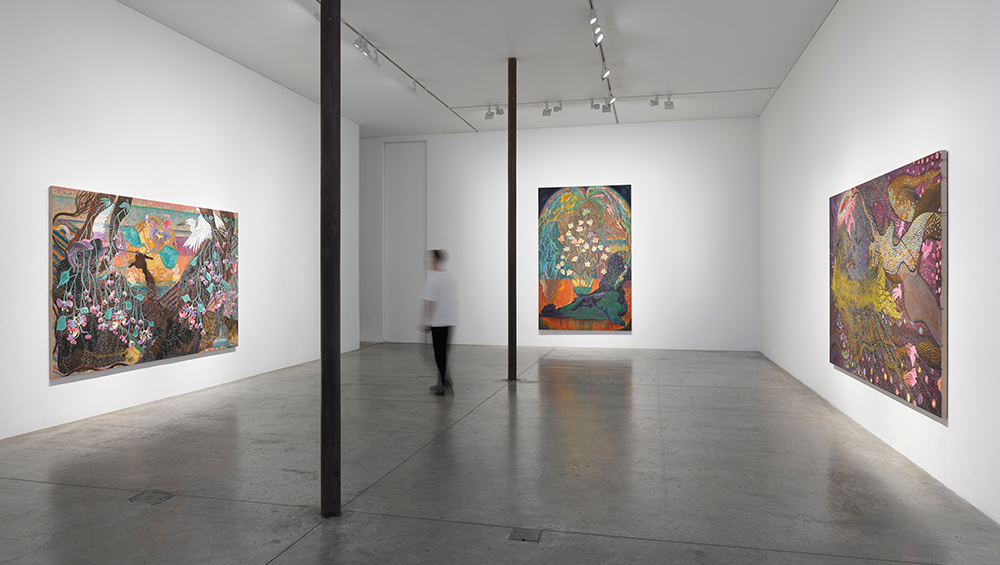
Chris Ofili: The Seven Deadly Sins, installation view, Victoria Miro, Wharf Road, London, 2023. © Chris Ofili. Courtesy the artist and Victoria Miro.
Victoria Miro, London
2 June – 29 July 2023
by BETH WILLIAMSON
It took Chris Ofili (b1968) six years to create this new series of monumental works on the subject of the seven deadly sins, a subject with biblical origins that closely relates to the human condition and human behaviour. Rather than illustrate individual sins (commonly defined as pride, envy, wrath, gluttony, lust, sloth and greed), the seven paintings reflect on the idea of sin and sinfulness. Ofili says: “The works are more about the inner feelings one has about the sin – not necessarily only in the moment of committal – than about what happens afterwards, or the idea of judgment.”
The artist, who was raised as a Roman Catholic, has long wanted to tackle such themes in his work. It was the Covid pandemic and the associated periods of enforced isolation that gave him the time he needed to embark on this challenging project. The paintings, made between 2017 and 2023, but tightly focused within the Covid and post-Covid era, encompass a spectrum of excessive and transgressive behaviours, although the titles of the seven lustrous works – The Fountain (2017-23), The Harvester (2019-23), The Swing (2020-23), The Crowning (2021-23), The Fall from Grace (2019-23), The Great Beauty (2020-23) and The Pink Waterfall (2019-23) – do not generally indicate sin or sinfulness. Still, in each instance the roughly six square metres of oil and charcoal on linen is a raucous and dangerous adventure of lust, indulgence and sheer unadulterated pleasure.
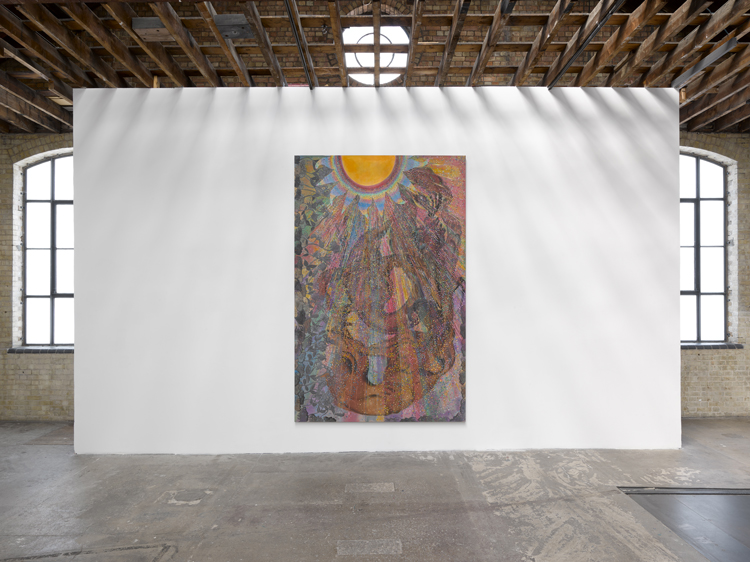
Chris Ofili: The Seven Deadly Sins, installation view, Victoria Miro, Wharf Road, London, 2023. © Chris Ofili. Courtesy the artist and Victoria Miro.
Each individual canvas is given an entire wall of the gallery across two floors of Victoria Miro’s Wharf Road space. It is as if we are being asked to contemplate these works in blissful isolation, to reflect on humanity’s flaws and failings as well as joys and pleasures in a thoughtful and focused manner. The Fall from Grace is hung upstairs in front of two large flanking windows, with a small round window above. This is an invitation to look almost worshipfully, but not quite, in a secular setting that is pseudo-religious in its look and feel. The line between what is sinful and what is righteous is not always clear. As Marlon James writes in the book that accompanies the exhibition: “Sometimes, I think sin is merely a good thing taken too far. Sloth is relaxation if black people relaxed like white people.”
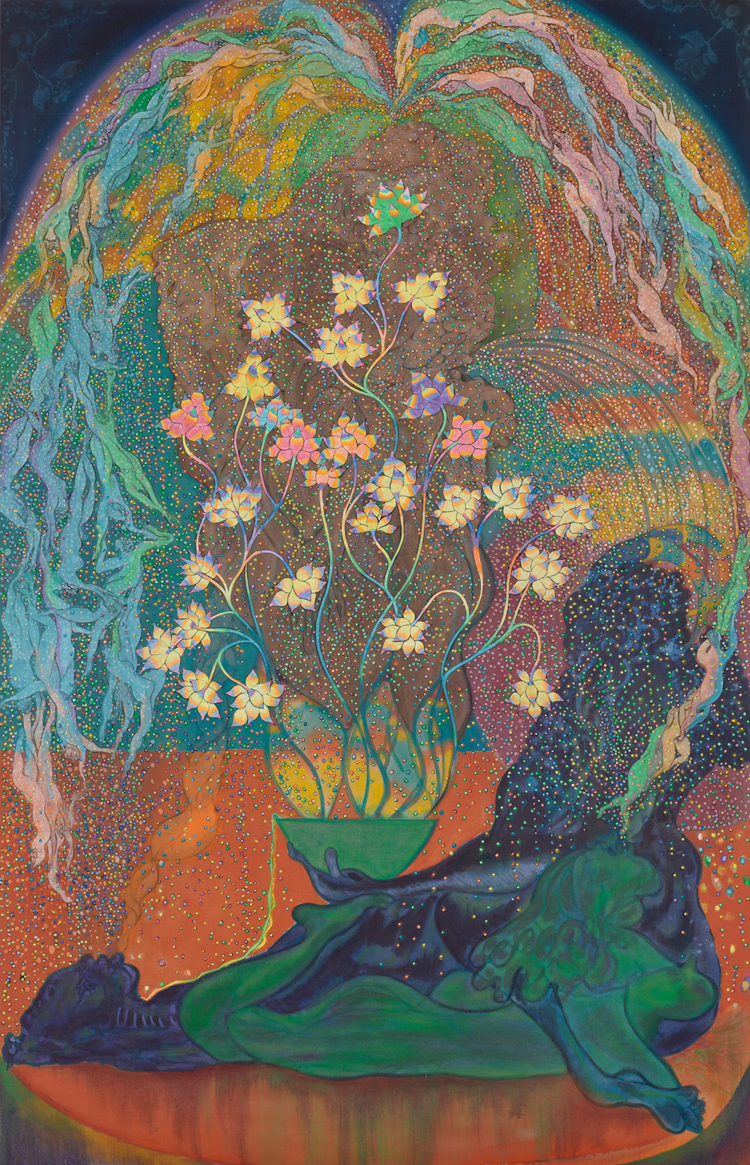
Chris Ofili, The Fountain, 2017-23. Oil and charcoal on linen, 310 x 200 cm (122 x 78 3/4 in). © Chris Ofili. Courtesy the artist and Victoria Miro.
All seven paintings are showered in pearlescent specks of paint that flow down the canvas in a colourful curtain of pointillist-style dots. This cascade of colour separates us from the sinfulness that lurks beneath, while simultaneously drawing us in closer to get a better look. Our curiosity triumphs as we strain to discover exactly what transgression is taking place here. These large canvases can be overwhelming, so to get up close and focus on smaller areas of the image makes it more manageable. It is easy to get lost in the act of looking as our eyes follow the twists and turns, the sins and surprises. In the midst of Ofili’s dreamscapes, it is difficult to know whether the cosmic territory he covers is paradisiacal, mythological or depraved. Everywhere we look there are references to a satyr, associated with the god Dionysus. Half man and half horse, the cloven-hooved satyr is a lustful being. In the depths of these sensual colourful landscapes his lean, muscular body tempts and teases from among the foliage and fleshy flowers, a glimpse of carnal excess in Ofili’s voluptuous visions. For instance, in The Fountain, three figures gather around a bowl or crucible, their sinful and carnal natures symbolised by the streams of tiny ghostly beings emitted from their open mouths to mingle with the billowing smoke from the bowl. As each element of Ofili’s composition feeds another, there is a sense of sin as a self-sustaining condition.
The accompanying book is a wondrously sensual object, too, filled with words that relate to Ofili’s theme in all sorts of ways. He invited seven writers to contribute – James, Hilton Als, Inua Ellams, Anthony Joseph, Ayanna Lloyd Banwo, Attillah Springer and Lynette Yiadom-Boakye – and while each of them has tackled the theme differently, they all add to our understanding of the artist’s interest in sin.
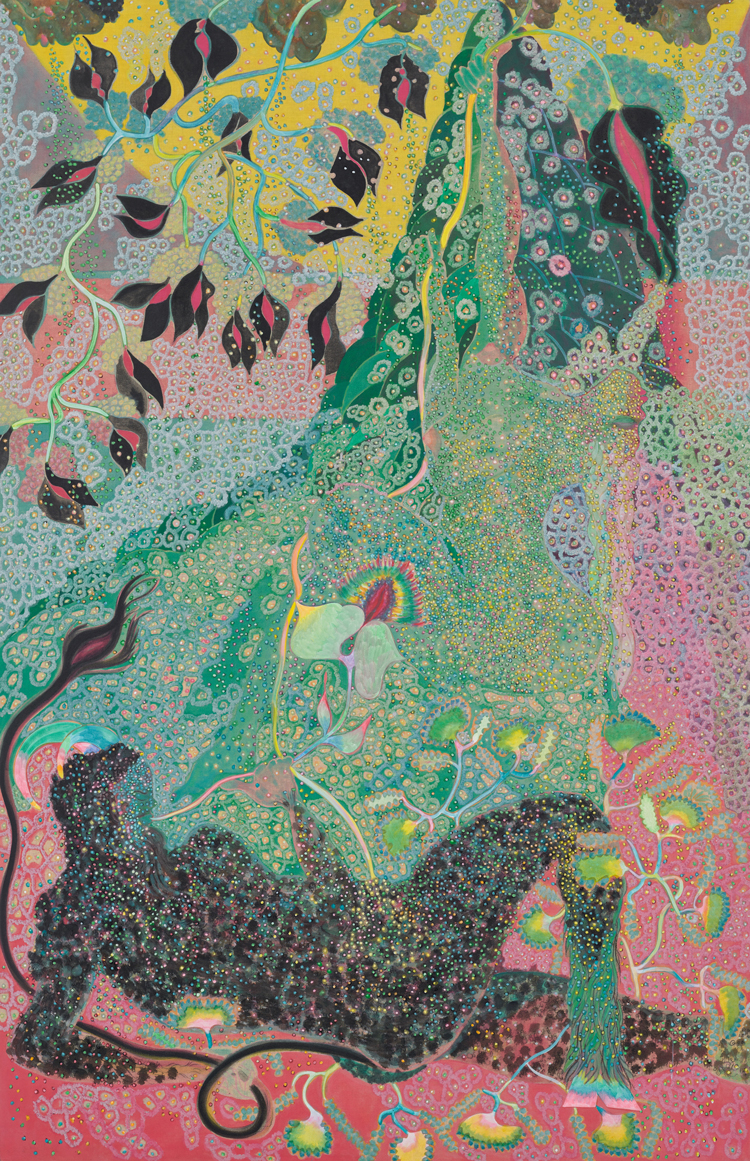
Chris Ofili, The Swing, 2020-23. Oil and charcoal on linen, 310 x 200 cm (122 x 78 3/4 in). © Chris Ofili. Courtesy the artist and Victoria Miro.
The painting The Harvester is dominated by the titular figure who reigns over an animated landscape colonised by streams of spore-like forms, redolent of a life force. Flowers on tendril stems appear to grow from the mouths and lips of the figures, a fecund ground for joy and surrender among the diaphanous ribbons of the Harvester’s domain. In The Fall from Grace, the only painting to directly reference sin in its title, Ofili makes a nod to the story of Icarus who flew too close to the sun and caused his feather-and-wax wings to melt. Two figures tumble downward in a stream of light and colour as the artist interrogates the liminality of sin and the line crossed in the act of a sin being committed. This brings us to the question of the potential for sin and how that, in itself, is often treated as if a sin has already been committed. This is beautifully explored in Banwo’s story Red Mango, in which even the playful, joyous nature of young children is turned sour when a visitor to their classroom pronounces: “The hearts of children … small as they may be, are the perfect vessels for sin.” It is as if there is no escaping their sinful fate without punishment and “the rod of correction” and yet what remains is the pleasure of a juicy red mango full of dripping sweetness. Inua Ellams’ 7 and Deadly, despite its interrogation of an aggressive racist encounter and the negative language and emotions associated with that, closes by recalling the seven virtues, including diligence, patience, kindness and humility. I could cite further examples from the work of other authors included here.
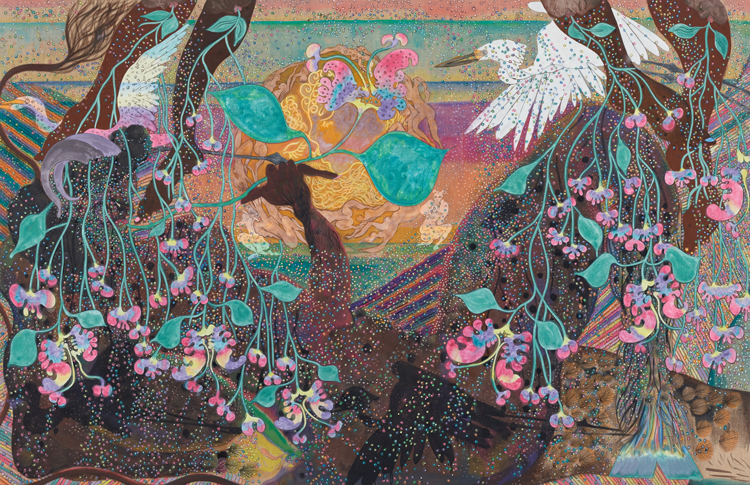
Chris Ofili, The Great Beauty, 2020-23. Oil and charcoal on linen, 200 x 310 cm (78 3/4 x 122 in). © Chris Ofili. Courtesy the artist and Victoria Miro.
As should be clear by now, the poems and stories in this book, like Ofili’s paintings, are not confined to illustrating a single sin but meditate more broadly on the question of sinfulness. This expansive exploration of the subject touches on everything from religious fundamentalism and ideas of original sin, to racially abusive encounters, and chilling reflections on the good and bad in humankind. It is a sobering read and one that helps to bring Ofili’s articulations into even sharper focus. The line between saints and sinners is not as clear as we might think.
• Chris Ofili: The Seven Deadly Sins is published by Victoria Miro, London, 2023, price £60.